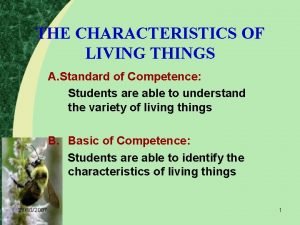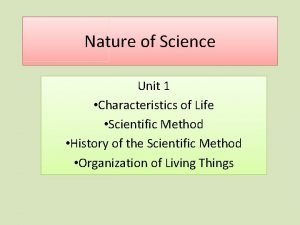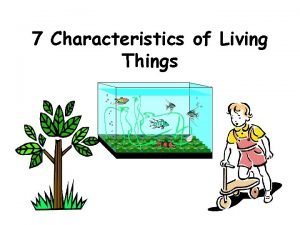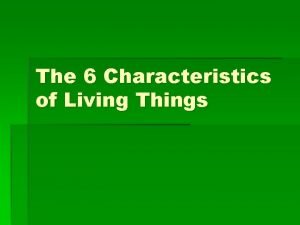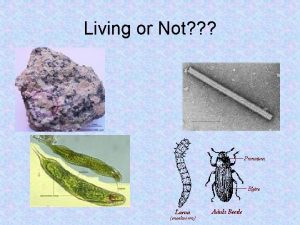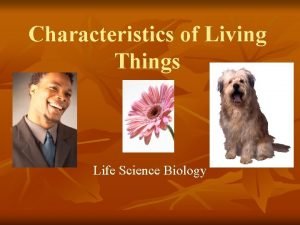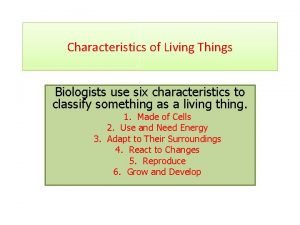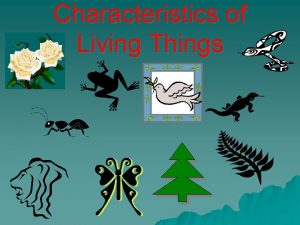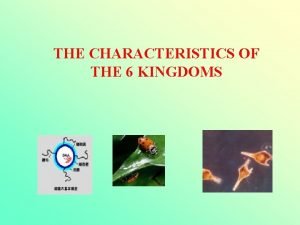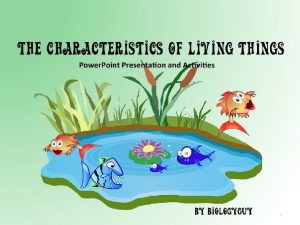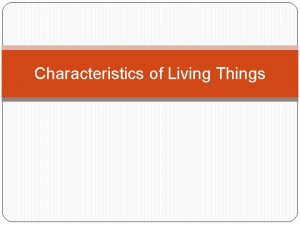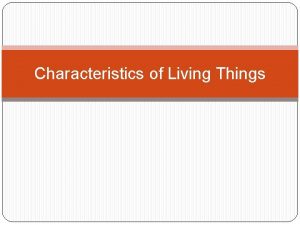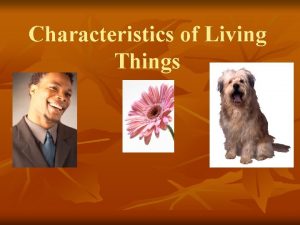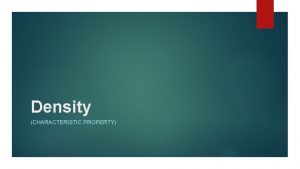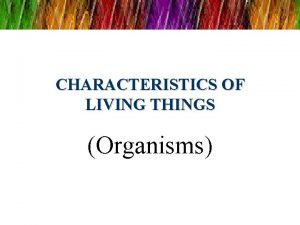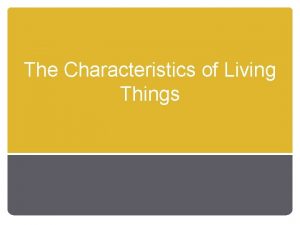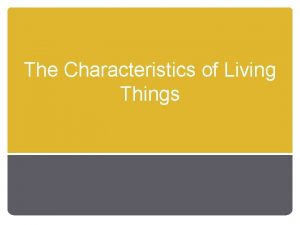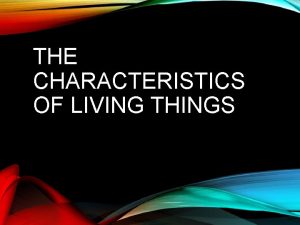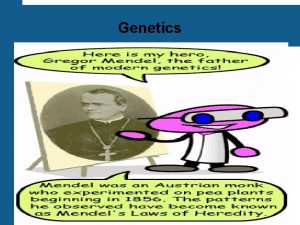Characteristics of Living Things Section 1 3 Characteristic













- Slides: 13

Characteristics of Living Things Section 1 -3 Characteristic Living things are made up of units called cells. Living things reproduce. Living things are based on a universal genetic code. Living things grow and develop. Living things obtain and use materials and energy. Living things respond to their environment. Living things maintain a stable internal environment. Taken as a group, living things change over time. Go to Section: Examples

Characteristics of Living Things Section 1 -3 Characteristic Examples Living things are made up of units called cells. Living things reproduce. Living things obtain and use materials and energy. Many microorganisms consist of only a single cell. Animals and trees are multicellular. Maple trees reproduce sexually. A hydra can reproduce asexually by budding. Flies produce flies. Dogs produce dogs. Seeds from maple trees produce maple trees. Flies begin life as eggs, then become maggots, and then become adult flies. Plants obtain their energy from sunlight. Animals obtain their energy from the food they eat. Living things respond to their environment. Leaves and stems of plants grow toward light. Living things maintain a stable internal environment. Despite changes in the temperature of the environment, a robin maintains a constant body temperature. Taken as a group, living things change over time. Plants that live in the desert survive because they have become adapted to the conditions of the desert. Living things are based on a universal genetic code. Living things grow and develop. Go to Section:

Figure 1 -21 Levels of Organization continued Section 1 -3 Organism Individual living thing Bison Tissues, organs, Groups of and organ systems Cells Brain Nervous tissue Cells Nervous system Smallest unit of life Nerve cell Groups of atoms; smallest unit of Molecules most chemical compounds Go to Section: Water DNA

Figure 1 -21 Levels of Organization Section 1 -3 Biosphere The part of Earth that contains all ecosystems Biosphere Ecosystem Community and its nonliving Surroundings. Both BIOTIC and ABIOTIC factors. Community Populations that live together in a defined area. Highest level of living things. Population Hawk, snake, bison, prairie dog, grass, stream, rocks, air Hawk, snake, bison, prairie dog, grass Group of organisms of one type that live in the same area Bison herd Go to Section:

A(n) is similar to a in that both. However, a(n) is different than a because Go to Section:

Videos Click a hyperlink to choose a video. It’s Alive!, Part 1 It’s Alive!, Part 2

Video 1 It’s Alive!, Part 1 Click the image to play the video segment.

Video 2 It’s Alive!, Part 2 Click the image to play the video segment.

Interest Grabber Answers 1. Working with a partner, think of several questions that a scientist might ask in order to understand why there are fish fossils in the desert of Wyoming. Write these questions on a sheet of paper. What other kinds of fossils have been found here? Is there evidence that a lake or inland sea existed in Wyoming at the time the fish lived here? 2. Discuss your questions with your partner, and suggest a possible answer to each question. Students may not be able to suggest answers for all of their questions. Students may know that most fish fossils formed in layers of mud and sand, which is evidence that the area was once under water. 3. How could a scientist go about finding an answer to each of the questions? Scientists would have to dig to look for more fossils and catalog what is found in the same layers with the fish. Geologists would have to map the fossil deposit and look for evidence of a lake shore or inland sea.

Interest Grabber Answers 1. Formulate a hypothesis that might explain the presence of the “worms” in the container. Students may say that the “worms” are immature beetles, or that there might have been worm eggs or worms in the oatmeal. 2. How could you test your hypothesis? If students thought that the worms were immature beetles, they may suggest isolating some of the worms to see if they develop into beetles. If students thought that there were eggs in the oatmeal, they may suggest taking a fresh sample of the oatmeal to see if worms hatch in it. 3. Identify the variables in your proposed experiment. Identify the control in your proposed experiment. Student answers should indicate that the control remains unchanged and is a standard of comparison. Variables are the factors that are subject to change.

Interest Grabber Answers Work with a partner to answer the following questions. 1. What are some similarities between the snowflake and the glass shell of the radiolarian? Both are tiny; both look crystalline. 2. What are some differences between the snowflake and the glass shell? Possible answer: The snowflake was not formed by a living thing, but the glass shell was. 3. Would you classify the shell as a living thing or a nonliving thing? Explain your answer. Students will likely say that the shell is nonliving, although it once surrounded the living that formed it.

Interest Grabber Answers 1. How does the height of the child compare to the diameter of the marble? The child’s height is 100 times the diameter of the marble. 2. How does the marble diameter compare to the diameter of the cell? The diameter of the marble is 100 times the diameter of the cell. 3. How does the height of the child compare to the diameter of the cell? The height of the child is 10, 000 times the diameter of the cell.

This slide is intentionally blank.
 10 characteristics of living things
10 characteristics of living things Nature of life science
Nature of life science Blue things
Blue things What is the smallest living unit
What is the smallest living unit The seven life processes of living things
The seven life processes of living things 7 characteristics of living things
7 characteristics of living things Six characteristics of living things
Six characteristics of living things Movement characteristics of living things
Movement characteristics of living things Six characteristics of living things
Six characteristics of living things The six characteristics of living things
The six characteristics of living things Two characteristics of living things
Two characteristics of living things Nine characteristics of living things
Nine characteristics of living things Characteristics of the 6 kingdoms
Characteristics of the 6 kingdoms Characteristics of living things mrs gren
Characteristics of living things mrs gren
